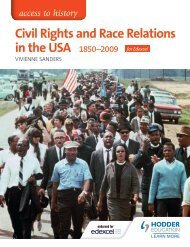SAMPLE
Sample-chapter-for%20Early-Elizabethan-England,-1558-1588,-Student-Book
Sample-chapter-for%20Early-Elizabethan-England,-1558-1588,-Student-Book
You also want an ePaper? Increase the reach of your titles
YUMPU automatically turns print PDFs into web optimized ePapers that Google loves.
WRITING<br />
HISTORICALLY<br />
WRITING<br />
HISTORICALLY<br />
Writing historically: managing sentences<br />
The most successful historical writing is clearly expressed, using carefully managed sentence structures.<br />
Learning outcomes<br />
By the end of this lesson, you will understand how to:<br />
••<br />
select and use single clause sentences<br />
••<br />
select and use multiple clause sentences.<br />
Definitions<br />
Clause: a group of words, or unit of meaning, that contains a verb, and can form part or all of a<br />
sentence (for example, ‘Elizabeth I reigned England from 1558’)<br />
Single clause sentence: a sentence containing just one clause, (for example, ‘Elizabeth I reigned<br />
England from 1558.’)<br />
Multiple clause sentence: a sentence containing two or more clauses, often linked with a conjunction,<br />
(for example, ‘Elizabeth I reigned England from 1558 and was known as ‘The Virgin Queen’.’)<br />
Coordinating conjunction: a word used to link two clauses of equal importance within a sentence<br />
(for example, ‘and’, ‘but’, ‘so’, ‘or’, etc.)<br />
How can I structure my sentences clearly?<br />
When you are explaining and exploring complex events and ideas, you can end up writing very long<br />
sentences. These can make your writing difficult for the reader to follow.<br />
Look at the extract below from a response to this exam-style question:<br />
Describe two features of the Revolt of the Northern Earls.<br />
England was a Protestant country but the Northern Earls and their followers aimed to bring<br />
back Catholicism in England so they began a revolt and at the beginning of the revolt they took<br />
control of Durham Cathedral and celebrated mass there.<br />
Draft material<br />
1. The writer of the response above has linked every piece of information in his answer into one, very<br />
long sentence.<br />
How many different pieces of information has the writer included in this answer? Re-write each<br />
piece of information as a single clause sentence. For example:<br />
The Northern Earls wanted England to be Catholic.<br />
2. Look again at your answer to question 1. Which of the single clause sentences would you link<br />
together? Re-write the response twice, experimenting with linking different sentences together<br />
using conjunctions such as ‘and’, ‘but’ or ‘so’. Remember: you are aiming to make your writing as<br />
clear and precise as possible.<br />
3. Write three two-clause sentences using conjunctions on the topic of the Revolt of the Northern<br />
Earls.<br />
4. Rewrite the response to the exam-style question, taking into consideration single clause sentences<br />
and the use of conjunctions.<br />
How can I use conjunctions to link my ideas?<br />
There are several types of multiple clause sentence structures that you can use to link your ideas.<br />
If you want to balance or contrast two ideas of equal importance within a sentence, you can use<br />
coordinating conjunctions to link them.<br />
Look at the extract below from a response to this exam-style question:<br />
Explain why the Catholic threat to Elizabeth I increased after 1566.<br />
Mary, Queen of Scots, arrived in England in 1568. Because she was a Catholic and had a link<br />
to the English throne, with the support of France, many saw her as a Catholic alternative to<br />
Elizabeth. This not only worried Elizabeth, but also gave many the chance to plot against her<br />
whilst Mary was close by. Mary continuously pressed her claim for the English throne, not face<br />
to face with Elizabeth but through letters, as Elizabeth refused to meet her in person.<br />
These coordinating conjunctions link equally important actions that happened at the same time.<br />
These paired coordinating conjunctions contrast two different means of communication.<br />
These paired coordinating conjunctions link and balance two equally important ideas.<br />
5. How else could the writer of the response above have linked, balanced or contrasted these ideas?<br />
Experiment with rewriting the response, using different sentence structures and different ways of<br />
linking ideas within them.<br />
Did you notice?<br />
The first sentence in the response above is a single clause sentence:<br />
Mary, Queen of Scots, arrived in England in 1568.<br />
6. Why do you think the writer chose to give this point additional emphasis by structuring it as a<br />
short, single clause sentence? Write a sentence or two explaining your ideas.<br />
Improving an answer<br />
Draft material<br />
7. Now look at the final paragraph below, which shows the response to the exam-style question above<br />
about the Catholic threat to Elizabeth I.<br />
After 1566, Elizabeth faced threats from many different Catholic foes. Mary, Queen of Scots,<br />
served as a constant reminder that she was a Catholic alternative to the Protestant Elizabeth.<br />
With this threat so close to home, plots were easily hatched. The Revolt of the Northern Earls<br />
was not a revolt of ordinary Elizabethan people. Many high-ranking members of the nobility<br />
were involved. Elizabeth could not underestimate these Catholic threats.<br />
Rewrite this paragraph, choosing some conjunctions from the Coordinating Conjunction Bank below to<br />
link, balance or contrast the writer’s ideas.<br />
Coordinating Conjunction Bank<br />
and<br />
not only... but also...<br />
but<br />
either... or...<br />
or<br />
neither... nor...<br />
so<br />
both... and...




